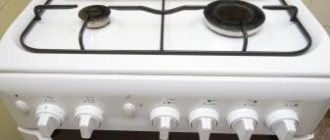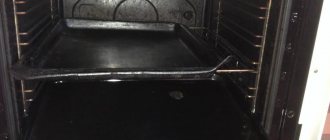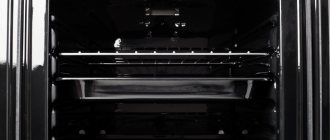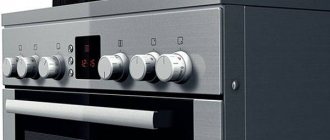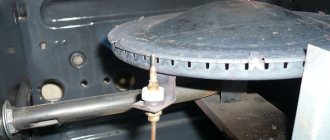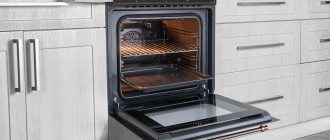Almost every modern gas stove is equipped with an oven. But not everyone knows how to ignite it. And this can be done, as a rule, in 2 or 3 ways, depending on the specific model of the gas stove itself. And many ovens also have several burners: one for main baking, the second for grilling. And here it will be much more difficult to figure it out.
So how to turn on the oven in a gas stove? In what ways can this be done, and in what ways is it absolutely impossible?
How to turn on the oven in a gas stove
You should start with the main burner.
There are 2 ignition options:
- manual;
- electric ignition (piez).
Manual ignition
This method is widely used in all models of gas stoves (Gefest, Electrolux and other manufacturers). The idea is extremely simple: you need to turn on the gas supply to the burner, then bring a lit match.
But you need to take into account that many stoves also have a heating indicator. Accordingly, even after the burner ignites, it is necessary to hold down the gas supply handle for another 5 - 10 seconds. Until the temperature sensor warms up.
What is the heating indicator for? It automatically closes the gas supply valve in cases where the burner in the oven goes out for any reason (strong draft, liquid from the dish being prepared, etc.).
When manually igniting, you must adhere to the following rules:
- Before turning on the igniter, you need to open the oven and ventilate it for 2 - 3 minutes. All unused baking sheets and other things (many people use the oven to store various utensils) must be removed.
- Bring a hot match to the burner.
- Turn on the gas supply. In some gas stoves, this can be done simply by turning the corresponding knob. In others, press it, then turn it and hold it in that position. Thirdly, all you have to do is press a special button. How exactly the gas supply to the burner is turned on should be clarified in the instructions for the specific gas stove model.
- After ignition, hold the knob (if it is pressed to supply gas) for another 5 - 10 seconds until the temperature sensor (thermocouple) warms up. Some models even have an indicator light that indicates when the handle can be released.
- If the fire on the burner burns evenly, there are no sparks or foreign burning smell, then you can close the door and leave the oven to warm up to the required temperature.
Where exactly is the burner (pilot) located? In most models - from below, under a protective metal casing. Some gas stoves have only a small hole at the bottom where you need to place a lit match.
IMPORTANT! First, they bring a match and only after that turn on the gas supply. Not the other way around! Otherwise, natural gas may accumulate in the oven and cause a small explosion when a source of fire appears. But this will be enough to cause injury and damage the gas stove itself.
And to ignite the oven manually, it is recommended to use special fireplace matches or a lighter with an extended nozzle.
But using a rolled-up newspaper or something similar is highly not recommended. Because the paper leaves behind soot, which can later clog the burner nozzles. It can also leave an unpleasant aftertaste on the prepared dish.
Electric ignition
Gas stoves equipped with electric ignition must be connected to the electrical network.
Although previously they produced models where a mechanical piezo element was installed. That is, there was a button, when pressed, a spark was generated. But this option is short-lived, so it was later abandoned.
So, if you have electric ignition, to turn on the oven you must:
- Turn the gas supply valve to “maximum”. In some stoves, for this you need to turn the handle all the way, in others - in the middle (use the marks).
- Press and hold the electric ignition button. In this case, corresponding “clicks” should be heard when a spark is applied.
- After the flame ignites, continue to hold the gas handle for another 5 - 10 seconds. This is necessary for the temperature sensor to warm up.
IMPORTANT! If it was not possible to light the oven the first time, then after 3–5 seconds the electric ignition button must be released. Next, open the door. Then either open a window in the house or run the hood. That is, the oven must be ventilated before attempting to ignite again.
If everything is done correctly, the burner ignites normally, does not spark, and there is no foreign smell, then you can close the door and heat the oven to the required temperature.
Types of electric ignition
Another nuance that needs to be taken into account: gas stoves have 2 types of electric ignition:
- Displayed on a separate button.
- Built into the gas handle.
Displayed on a separate button
As a rule, the corresponding button is located to the left or right of the knobs, which, when turned, turns on the gas supply. First you need to turn the handle and only then press this button.
The oven door should be open at this moment! This is necessary in order to prevent the accumulation of gas inside.
Built into the throttle handle
Everything is much simpler here. When you turn the knob, the gas supply immediately opens, then the spark supply automatically turns on.
It should be taken into account that the piezo is triggered only at that moment if the handle is in the “maximum” position (that is, the strongest fire).
Conclusions and useful video on the topic
Why is it important to follow the rules when connecting gas appliances:
Why do you need a dielectric gasket:
Oven installation procedure:
https://youtube.com/watch?v=_W4C60Pvooo
It seems that installing the oven is easy. It is necessary to follow certain steps sequentially and take care of the tight connection of all nodes. In practice, inept craftsmen make serious mistakes.
An almost imperceptible gas leak often leads to serious losses, as well as more dire consequences - illness and death. Therefore, for the sake of safety, it is better to invite a professional with the necessary knowledge to perform this type of work.
How to light a grill
Technically, a grill burner is no different. It is located, as a rule, in the upper part of the oven (sometimes slightly shifted to the side). You also just need to bring a burning match or lighter.
But here you still need to install a spit first. And immediately after ignition, turn on the “grill” mode. If there is convection, it will be automatically started (we are talking about a fan). In other models, the spit is installed only with the oven door slightly open.
Cooking modes
The Ariston electric oven has 7 different positions.
- Traditional mode. It operates the upper and lower heating elements. The set temperature is maintained automatically. Hot air is directed from top to bottom. To ensure even heat distribution, it is preferable to use 1 baking sheet.
- Confectionery mode. Designed for a delicate process using only the rear heating element. Ideal for preparing yeast products.
- Fast cooking mode. In this case, all heating elements operate simultaneously, distributing heat evenly. Recommended for preparing frozen foods.
- Multi mode Designed for simultaneously cooking several dishes that have the same cooking temperature. Two heating elements and a fan are working.
- Pizza mode. The bottom heating element is working. The hot air flow is supplied from bottom to top.
- Grill mode. The process takes place with the light on. Thermal infrared radiation travels from the top heating element.
- Ventilated grill. The top heating element and fan are functioning.
Article on the topic: How to calculate the power of a gas stove
What to do if the electric ignition does not work
The main reasons why electric ignition may not work:
- no electricity;
- the cable is not plugged into the socket;
- the spark supply unit has failed (most often it is the capacitor that is faulty, which discharges when the button is pressed; it needs to be replaced).
What to do in this case? Use manual arson. It is technically provided in absolutely all gas ovens and cookers. But you will need either fireplace matches or a lighter with an extended nozzle.
Again, just open the door and look for the burner in the lower or upper part. If it is closed with a special casing, then there must be a hole for ignition. By the way, in most cases this same casing can be removed (this is necessary for servicing the burner).
What to do if the oven goes out after lighting
The most common reasons why this happens:
- The gas supply valve is not fully open (the one located next to the hose that connects the gas pipeline pipe and the stove itself). Need to check.
- There is not enough air for ignition. That is why the door must be opened before this, and the oven itself must be thoroughly ventilated for 2 - 3 minutes.
- The burner is dirty. It is not recommended to attempt to clean or service it yourself. It is recommended to seek help from specialists.
- The burner was moved. Most often this happens after the inner chamber has been cleaned of dirt. You need to check the position of the burner and, if necessary, set it correctly.
- Low pressure in the gas pipeline. This can be identified by the burners of the gas stove itself. If the fire burns weakly, then the problem is clearly this or a failed faucet valve. It is necessary to contact a representative of the emergency gas service for assistance.
- The temperature sensor (thermocouple) is faulty. As a rule, it burns out after 3 to 5 years of active use. In this case, the fire goes out immediately after releasing the gas handle, even if it is held for more than 30 - 40 seconds. To fix the problem, you need to replace the thermocouple, that is, you should contact a service center.
IMPORTANT! After the oven goes out, it must be ventilated before attempting to re-ignite.
Precautions when using a gas stove
When using a gas stove oven, you must adhere to the following safety rules:
- When the oven door is closed, gas may accumulate in it if the burner allows it to pass through for some reason. That is why before ignition the oven chamber must be ventilated for 2 - 3 minutes. And using a gas stove is only allowed in a well-ventilated room (that is, with supply ventilation).
- When the burner is lit, there should be no “empty” areas where there is no fire. If there are any, then you must immediately turn off the gas supply and contact a service center for cleaning. In some models, you can do this yourself (you should follow the algorithm presented in the instructions).
- A working oven must be constantly supervised. It is for this reason that this technique does not have automatic baking programs with automatic shutdown. After all, if this function does not work for any reason (for example, a valve gets stuck), this will lead to a fire!
- Under no circumstances should you use a gas stove oven to heat a room. With the door ajar, it can only be used in one case - using a grill. In many gas stoves, to ensure normal convection (air circulation), a special strip is provided, which holds the door ajar.
- After each use of the oven, the inner chamber must be cleaned of dirt. And how exactly this is done is indicated in the instructions.
- If there are signs of an oven malfunction or a leak in the gas hose connection, then using such a stove is strictly prohibited.
In total, figuring out how to turn on the oven in a gas stove is quite simple. Especially if it is equipped with electric ignition. Indeed, in this case, you just need to turn the handle, and then press the button to turn on the piezo element.
But the most important thing is to take precautions when using such equipment.
Features of the first launch
When starting up both a gas and electric oven for the first time, you need to carefully read the manufacturer's recommendations. This will save you from many mistakes and avoid damage to the device.
All internal surfaces and components must be thoroughly washed, and the utensils used must be placed inside for calcination. This will remove from the surfaces any remaining packaging materials, shipping oils and other substances that can release unpleasant odors and toxins.
Before cooking food, the oven must first be preheated.
To calcine the oven, it must be turned on at maximum temperature for about 1-1.5 hours. During the procedure, unpleasant odors may appear in the kitchen, which should not cause concern. The exception is persistent odors of burning and smoke. In this case, you need to stop calcination and figure out what the reason is. In other cases, calcination must be carried out several times until the unpleasant odors completely disappear.
After such cleaning, the oven should be wiped with a damp cloth and left to air.
Immediately before cooking for the first time, you should try to get used to the new oven:
- select the optimal temperature regime;
- understand what height position of the grille is necessary;
- calculate the heating speed of the oven.
Before cooking for the first time, you need to get used to the features of the oven.

